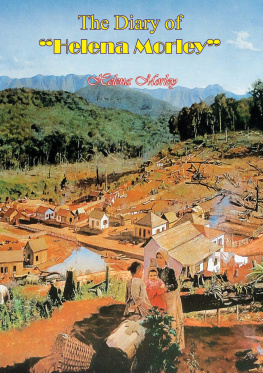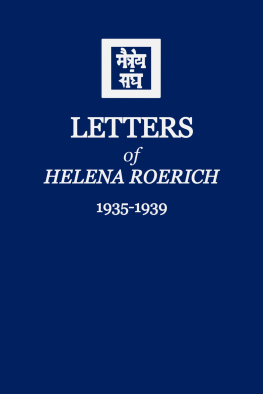Helena Morley - The Diary of “Helena Morley”
Here you can read online Helena Morley - The Diary of “Helena Morley” full text of the book (entire story) in english for free. Download pdf and epub, get meaning, cover and reviews about this ebook. year: 2016, publisher: PicklePartners, genre: Art. Description of the work, (preface) as well as reviews are available. Best literature library LitArk.com created for fans of good reading and offers a wide selection of genres:
Romance novel
Science fiction
Adventure
Detective
Science
History
Home and family
Prose
Art
Politics
Computer
Non-fiction
Religion
Business
Children
Humor
Choose a favorite category and find really read worthwhile books. Enjoy immersion in the world of imagination, feel the emotions of the characters or learn something new for yourself, make an fascinating discovery.
- Book:The Diary of “Helena Morley”
- Author:
- Publisher:PicklePartners
- Genre:
- Year:2016
- Rating:4 / 5
- Favourites:Add to favourites
- Your mark:
- 80
- 1
- 2
- 3
- 4
- 5
The Diary of “Helena Morley”: summary, description and annotation
We offer to read an annotation, description, summary or preface (depends on what the author of the book "The Diary of “Helena Morley”" wrote himself). If you haven't found the necessary information about the book — write in the comments, we will try to find it.
The Diary of “Helena Morley” — read online for free the complete book (whole text) full work
Below is the text of the book, divided by pages. System saving the place of the last page read, allows you to conveniently read the book "The Diary of “Helena Morley”" online for free, without having to search again every time where you left off. Put a bookmark, and you can go to the page where you finished reading at any time.
Font size:
Interval:
Bookmark:


This edition is published by PICKLE PARTNERS PUBLISHINGwww.pp-publishing.com
To join our mailing list for new titles or for issues with our bookspicklepublishing@gmail.com
Or on Facebook
Text originally published in 1957 under the same title.
Text originally published in Portuguese in 1942 as Minha Vida de Menina .
Pickle Partners Publishing 2016, all rights reserved. No part of this publication may be reproduced, stored in a retrieval system or transmitted by any means, electrical, mechanical or otherwise without the written permission of the copyright holder.
Publishers Note
Although in most cases we have retained the Authors original spelling and grammar to authentically reproduce the work of the Author and the original intent of such material, some additional notes and clarifications have been added for the modern readers benefit.
We have also made every effort to include all maps and illustrations of the original edition the limitations of formatting do not allow of including larger maps, we will upload as many of these maps as possible.
THE DIARY OF HELENA MORLEY
BY
HELENA MORLEY
Translated from the Portuguese by
ELIZABETH BISHOP
Contents
When I first came to Brazil, in 1952, I asked my Brazilian friends which Brazilian books I should begin reading. After naming some of Machado de Assiss novels or short stories, or Euclides da Cunhas Os Sertes , they frequently recommended this little book. Two or three even said it was the best thing that had appeared in Brazilian letters since Machado de Assis, and then they were apt to launch into animated exchanges of their favorite stories from it.
In English the title means My Life as a Little Girl, or Young Girl, and that is exactly what the book is about, but it is not reminiscences; it is a diary, the diary actually kept by a girl between the ages of twelve and fifteen, in the far-off town of Diamantina, in 1893-1895. It was first published in 1942 in an edition of 2,000 copies, chiefly with the idea of amusing the authors family and friends, and it was never advertised. But its reputation spread in literary circles in Rio de Janeiro and there was a demand for it, so in 1944 a second edition was brought out, then two more, in 1948 and 1952, making 10,000 copies in all. George Bernanos, who was living in the country as an exile when it first appeared, discovered it and gave away a good many copies to friends, a fact to which the author and her husband modestly attribute much of its success. He wrote the author a letter which has been used, in part, on the jackets of later editions. Copies of Minha Vida de Menina are now presented every year as prize-books to students of the Convent of the Sacred Heart in Rio.
The more I read the book the better I liked it. The scenes and events it described were odd, remote, and long ago, and yet fresh, sad, funny, and eternally true. The longer I stayed on in Brazil the more Brazilian the book seemed, yet much of it could have happened in any small provincial town or village, and at almost any period of historyat least before the arrival of the automobile and the moving-picture theatre. Certain pages reminded me of more famous and literary ones: Nausica doing her laundry on the beach, possibly with the help of her freed slaves; bits from Chaucer; Wordsworths poetical children and country people, or Dorothy Wordsworths wandering beggars. Occasionally entries referring to slavery seemed like notes for an unwritten, Brazilian, feminine version of Tom Sawyer and Nigger Jim. But this was a real, day-by-day diary, kept by a real girl, and anything resembling it that I could think of had been observed or made up, and written down, by adults. (An exception is Anne Franks diary; but its forced maturity and closed atmosphere are tragically different from the authentic childlikeness, the classical sunlight and simplicity of this one.) I am not sure now whether someone suggested my translating it or I thought of it myself, but when I was about halfway through the book I decided to try.
I learned that Helena Morley was still very much alive; that the name was the pseudonym of Senhora Augusto Mario Caldeira Brant and that she was living in Rio, well-known and much loved in Rio society. Her husband was then, although almost eighty years old, acting as President of the Bank of Brazil for the second time. The poet Manuel Bandeira, an old friend of the family, kindly gave me an introduction. Armed with a friend, Lota de Macedo Soares, to serve as interpreter because my spoken Portuguese was very limited, I went to call.
Senhora Brant, or Dona Alice as I shall call her in the Brazilian way (Helena and Morley are both names from her English fathers family), now lives in a large, stuccoed, tile-roofed house, on the street that borders the Laga, or lagoon. It is a fashionable place to live. The house is set in a yard with flowerbeds, coconut palms, eight fruit trees and a servants house and vegetable garden at the back. A stuccoed fence and wooden gates protect it from the street. A large Cadillac is sometimes parked in the driveway, and its mulatto chauffeur wears a white yachting cap: Cadillac, chauffeur, and white cap are all contemporary Rio fashion. Nearby rise the extravagant Rio mountains and across the lagoon towers the one called the Gavea, or crows nest, because its shape reminded the sixteenth century Portuguese explorers of the lookout platforms on their little vessels.
On our first visit we were ushered into a large living-room, parlor, rather, with its silk and lace curtains closely drawn, luxuriously furnished: vases, bronzes, and clocks on small tables, rugs, a chandelier, chairs and sofas covered in gold-colored satin. This room is divided from the hall and another living-room opposite by a fence and gateway of wrought iron, painted white. One of Dona Alices daughters, Dona Sarita, appeared and started talking to my friend. Although they had not met before, very shortly they were identifying and placing each others relatives, something that seems to happen in Brazil as quickly as it does in the south of the United States, when Dona Alice herself came in.
She is a large woman, very tall for a Brazilian, looking younger than seventy-six, her hair not yet entirely white, with a handsome, lively, high-cheekboned face lit up by two small but exceedingly bright and gay reddish-brown eyes. Her half-English blood shows, perhaps, in the unusual fairness of her skin, the fairness that made her liable to the freckles she used to complain of in her diary. She began talking, laughing and talking, immediately, and in no time at all we were telling each other stories and Dona Alice was leaning forward to pat our knees with the greatest ease and intimacy. (This warmth and ease in meeting strangers is a Brazilian characteristic especially charming to Nordic visitors.) At the first interview a great deal of the conversation was lost to me. However, I did gather that Dona Alice was proud of the book she had unwittingly written more than sixty years before, pleased at the thought of its being put into English, and still somewhat puzzled by its success in Brazil and the fact that George Bernanos, French people, and more recently, Americans, had seemed to like it, too. I could also recognize her retelling of some of the anecdotes in the very words of the diary, or in more detail, and with a great deal of hilarity.
Next pageFont size:
Interval:
Bookmark:
Similar books «The Diary of “Helena Morley”»
Look at similar books to The Diary of “Helena Morley”. We have selected literature similar in name and meaning in the hope of providing readers with more options to find new, interesting, not yet read works.
Discussion, reviews of the book The Diary of “Helena Morley” and just readers' own opinions. Leave your comments, write what you think about the work, its meaning or the main characters. Specify what exactly you liked and what you didn't like, and why you think so.











